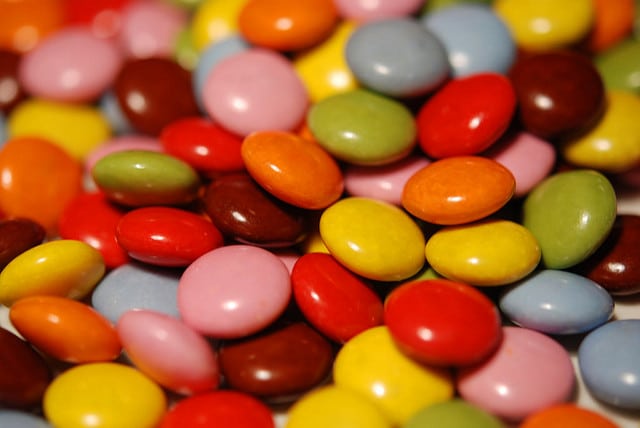Using FDA Guidelines and Consumer Trends When Labeling Foods Containing Color Additives

The type of color additive you use and how it appears on your label is important to consumers. Image Source: Flickr user Naitokz.
As a kid, I remember walking down the cereal aisle in the grocery store and begging my mom to buy me a box of Lucky Charms. Despite my incessant whining, she never let me have them. “Whatever gives them those crazy colors can’t be good for you,” she’d say. It wasn’t that she was overly health-conscious, she just really didn’t trust fluorescent or pastel shades in food.
Today, consumers are becoming increasingly concerned with artificial ingredients in the foods they purchase. Despite the FDA declaring certain color additives safe, many people scour labels and inspect ingredients for colorings because they perceive these ingredients as potentially harmful to their health. As a food manufacturer who intends to use or might be considering using color additives in their products, it’s vital to understand both the FDA guidelines and public perception of color additives when creating an effective product label.
The FDA and Color Additives
The FDA breaks color additives down into two main categories: certified colors and colors that are exempt from certification. “Green No. 2” and “Yellow No. 5” are both examples of certified colors which are chemically manufactured. They’re intensely pigmented hues, permitting uniformity and consistency in color among food products. Currently, there are only nine certified color additives permitted for use in the U.S. and deemed safe by the FDA (although there is a disclaimer that no ingredient can be proven absolutely safe). Colors exempt from certification, on the other hand, are additives naturally derived from animal, vegetable, or mineral sources. Examples include beet powder, annatto, and ultramarine blue. These tend to be more varied in color, less pigmented, and can, in some cases, impart mild flavors to the food product.
If you are a manufacturer who intends to use color additives of either variety, you must be aware of specific FDA requirements when it comes to labeling. If you decide to use certified colors in your product, you must include them on your ingredient list and name the specific color used (ie. “FD&C Red Nos. 3 and 40”). Colors exempt from certification also need to appear on the ingredient list, but they do not need to be mentioned specifically by name (with the exception of cochineal extract and carmine). For instance, if you use beet powder to color a red licorice product, it can simply appear as “colorings” or “color added”—though you may include the name of the specific coloring agent if you wish.
Public Perception of Color Additives
The American public is reading food labels now more than ever, and color additives, in particular, have come under a lot of scrutiny, thanks to studies and anecdotes linking certain color additives to hyperactivity in children and allergic reactions. The FDA considers such information inconclusive and says that more scientific research is needed to be certain that these additives present health risks.
The problem is, despite the increase in public knowledge and growing interest in nutrition, most people aren’t aware of the difference between FDA certified (synthetic) color additives and exempt (natural) color additives. Many people think all added color has the potential to be harmful. For example, if a discerning consumer picks up a product and sees “Yellow No. 5,” they will likely understand that the additive is synthetic because the name is explicitly stated.
But if a consumer sees “artificial colors added” or “color added” on a label, they may assume that coloring is also artificial—even though this is the way that exempt, naturally derived color additives are supposed to be labeled. Food manufacturers often want to clarify this confusion by using the word “natural” to describe the color, but the FDA doesn’t allow the use of this word on your label in reference to any color additive because the color does not naturally occur in your product.
If your goal is to appeal to the growing health-conscious demographic, your best bet is to choose an exempt color additive and label it wisely. Consumers want transparency, and “artificial color added” is much more vague and suspicious than “beet powder.” Generally, if the exempt color is one they are familiar with—as in the case of turmeric or beets—then it is a good idea to identify it. But if you are using ultramarine blue or synthetic iron oxide—two exempt color additives that consumers may not be familiar with and that sound like they may be synthetic—it may be better to use the term “color added.” Although it is completely up to you to decide what color additives you include in your product (whether synthetic or naturally derived), these can be important considerations when it comes to marketing.
Effective Labeling with LabelCalc
Using color additives in your food product has some layers of complexity, to say the least. If FDA guidelines weren’t enough to consider, you’ve got to take into account the public’s perception when choosing a color additive. My mother may have been unique in her distrust of the highlighter fluorescent hues coming out of my favorite cereal boxes, but nowadays, this belief is quite common. If these types of individuals are your target market, using a naturally derived color additive and labeling it effectively could make a difference in the success of your product. But regardless of which color additive you choose or how you list it on your label, the most important thing is that you follow the FDA’s guidelines for certified color additives and exempt color additives. If you need help navigating the complex world of color additives and creating your FDA-approved nutrition label, trust LabelCalc for expert guidance.

